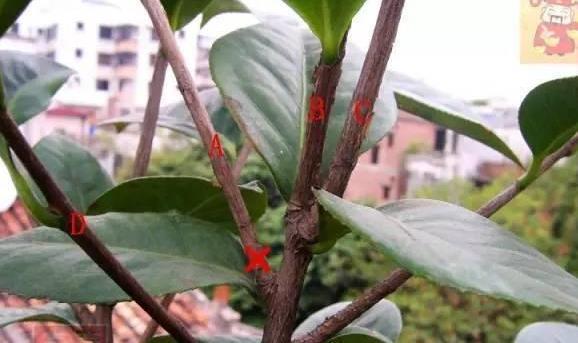It is not difficult to cut a branch and burst a pot with 10 flowers.

Camellia
Cut off the overdense branches
The distance between ▼ A branch and B branch D branch is close, so we can consider cutting off A branch. B and C branches are parallel and closely spaced, so you can consider cutting off one of them.
The branches at the top of the ▼ are so dense that you can consider cutting off some of them. × indicates the location of the pruning. The cut is as close to the branches as possible.
After pruning
Gardening scissors, specializing in cutting thick branches. Try not to use the ordinary scissors at home, not only sharpen your hands, but also cause the incision to be too large, affecting the recovery in the later stage. Cut off the dead branches
▼ tip bud head necrosis, should be pruned, one is to accumulate nutrients, reduce waste; the other is to make room for the growth of the branches behind. The position shown by the double arrow is the hint of shrinking pruning.
Contrast the picture after pruning
Cut off the lower branch.
▼ An and B are the lower branches, and the branches are weaker than the C branches, which will consume too much nutrients of the plant and should be cut off. The cut is as close to the branches as possible.
The red × part of ▼ is also the lower branch, and the branch potential is weaker than An and B branches, which will consume too much nutrients of the plant, so it should be cut off.
Cut off overlapping branches
The overlapping young shoots sprouting on the main pole of ▼ can be cut off in order to accumulate nutrients and reduce waste. The red x part is the pruning tip. It can be trimmed as indicated by the double arrows.
The denser branches at the top of ▼ can be removed, and some red branches are tips for pruning; the arrows show axillary buds and should be erased at the same time.
The comparison picture after pruning
The leaf buds that cannot grow normally in ▼ should be cut off, and the position indicated by the double arrow is the pruning prompt.
▼ downward, horizontal leaf buds should be erased, the arrow shows that the leaf buds, the growth is downward, can not accept enough light, can be directly cut off.
The ▼ arrow shows lateral (accessory) buds, which should be erased. If the buds are not wiped in time, they will produce parallel thin branches.
If it is not erased, it will eventually grow like the following picture. The weaker branches on the left are the branches from the lateral buds, while the stronger ones are the branches from the main buds. At this time, the thin branches on the left should also be removed. The lateral buds on strong branches should also be removed.
Contrast the picture after pruning
The overlapping horizontal buds after the ▼ flowering should be cut off, which is the bud pointed to by the arrow.
▼ A branch is a short branch with flowers in the same year, which will consume too much nutrients after flowering, so it should be cut off. Some of the red fork branches are tips for pruning. The arrow shows axillary buds and should be erased.
Gardenia
Many gardenia flowers raised by flower friends are not pruned and think that they grow best naturally. First, the shape of the tree is not beautiful, and it is easy to grow; second, the branches are not thick and strong, and they cannot be supported by cutting them in the future; third, there are very few buds in the coming year; fourth, pruning means that the branches are mature, and the branches will only become pregnant buds when they are mature, and there will be more buds in the coming year. So pruning is very important.
The pruning of gardenia is very important. I'll teach you how to do it hand in hand.
As shown in the figure:
① lobular gardenia
② big leaf gardenia
To cut off weak branches.
The buds on both sides of the bud will compete with the bud for nutrients and can be cut off properly.
Cut off the residual flowers. When trimming, don't just pick the residual flowers. You can cut them from the second section below the flowers.
It is best to cut off the buds on both sides of the bud before the bud opens. If you forget to trim, you can also cut the residual flowers.
- Prev

Do you want the screen on the table facing up or down? Most people are wrong.
If the phone is on the table, do you want the screen facing up or down? Most people are wrong! Do you like this article? Share it now and let more people know! The content of this site is rich, extensive and profound, and the editor selects daily hot information.
- Next

Do you think it is necessary for farmers to farm in 2019? Why?
Do you think it is necessary for farmers to farm in 2019? Why? Farmers not only need to farm in 2019, but also continue to plant the land, farmers do not farm, what to eat, how to stabilize the country, how to develop society.
Related
- Wuhan Hospital Iron Tree Blooming Result Was Instantly Frightened by the Gardener Master
- Which variety of camellia is the most fragrant and best? Which one do you like best?
- What is the small blue coat, the breeding methods and matters needing attention of the succulent plant
- Dormancy time and maintenance management of succulent plants during dormancy
- Minas succulent how to raise, Minas succulent plant pictures
- What are the varieties of winter succulent plants
- How to raise succulent plants in twelve rolls? let's take a look at some experience of breeding twelve rolls.
- Attention should be paid to water control for succulent plants during dormant period (winter and summer)
- Watering experience of twelve rolls of succulent plants
- Techniques for fertilizing succulent plants. An article will let you know how to fertilize succulent plants.

